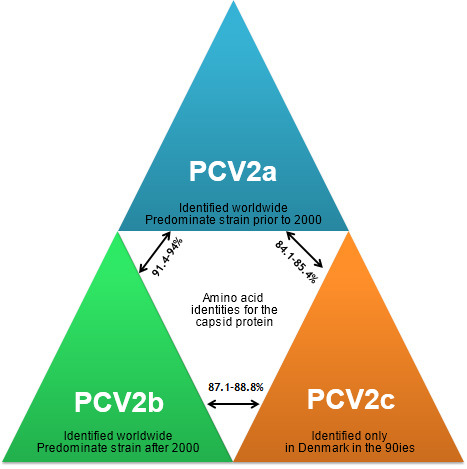Porcine circovirus type 2 (PCV2) is linked to several clinical disease manifestations in all stages of pig production commonly referred to as PCV-associated diseases (PCVAD). Clinical signs associated with PCV2 infection can include wasting, weight loss, diarrhea, respiratory disease (sneezing, nasal discharge, increased respiratory rates), jaundice, anemia, and skin lesions. Vaccination is a tool that is frequently used to reduce or prevent the economic losses associated with PCV2 infection.
What are the main PCV2 genotypes?

On a genetic level, PCV2 isolates can be divided into three main genogroups: PCV2a, PCV2b, and PCV2c (Fig. 1). Both PCV2a and PCV2b occur worldwide. PCV2a was the predominant PCV2 genotype until 2000 at which time a global shift in genotypes started to occur resulting in PCV2b being the predominant genotype since 2000. When PCV2b initially entered North America, it spread rapidly across swine production regions devastating the swine industry with high mortality and morbidity.
Fig. 1. Main PCV2 genotypes and their relationship based on the capsid gene.

Are vaccines protective against all currently circulating PCV2 genotypes?
The main commercial PCV2 vaccines available to date are all based on PCV2a strains. Experimental studies by our group and others indicate that there is sufficient cross protection between PCV2a and PCV2b strains. This is further supported by field evidence which indicates that vaccination of pigs with a PCV2a-based vaccine is generally very effective in reducing PCVAD on a global basis.
Characterization of recent PCV2a and PCV2b strains indicate the presence of new variants
Sequencing of the capsid gene of PCV2 during field investigations led to the discovery of several PCV2 mutants and variants in recent years. One of these mutants, a PCV2 strain initially discovered in China, possesses several amino acid mutations throughout the capsid gene. Chinese researchers have demonstrated in an experimental pig model that this strain is more virulent than traditional Chinese PCV2a and PCV2b strains thereby increasing international concern about the emergence and spread of novel PCV2 variants. Earlier this year, a similar strain was also identified by our group in North America in several cases of perceived vaccine failures where severe PCVAD occurred in vaccinated pig herds. In addition to this particular strain, other PCV2a and PCV2b variants with individual amino acid capsid mutations in known immunogenic regions were also identified perhaps indicating a positive selection of viruses containing certain capsid mutations or perhaps even insufficient vaccine protection by current PCV2 vaccine strains. Alternatively, the findings may be just incidental as the implications of these amino acid changes yet need to be determined.
Available tools for characterization of PCV2 isolates
Good diagnostic tools are available and commonly used for demonstration of PCV2 in tissues or sera. These include tools to demonstrate PCV2 infection such as immunohistochemistry or in-situ-hybridization on formalin-fixed tissues or PCR based assays on tissues, serum samples, or oral fluids. Some PCR based assays are also able to identify and differentiate between PCV2a and PCV2b genotypes. Several serological assays are available to demonstrate the presence of anti-PCV2 antibodies in serum samples or oral fluids. The current serological assays only indicate exposure to PCV2 and therefore are not sufficient to identify small but perhaps important genomic changes. Sequencing of the virus may provide additional very important information. Sequencing can be conducted only on the capsid gene or on the entire virus. Typically, sequencing of the capsid appears to be sufficient for surveillance purposes. Monitoring of changes using a central database to identify any consistent changes now seems warranted for PCV2. Regardless of genomic changes between viruses, it is important to verify that such changes are indeed associated with increased virulence or decreased immunogenicity to be able to implement appropriate intervention strategies.





